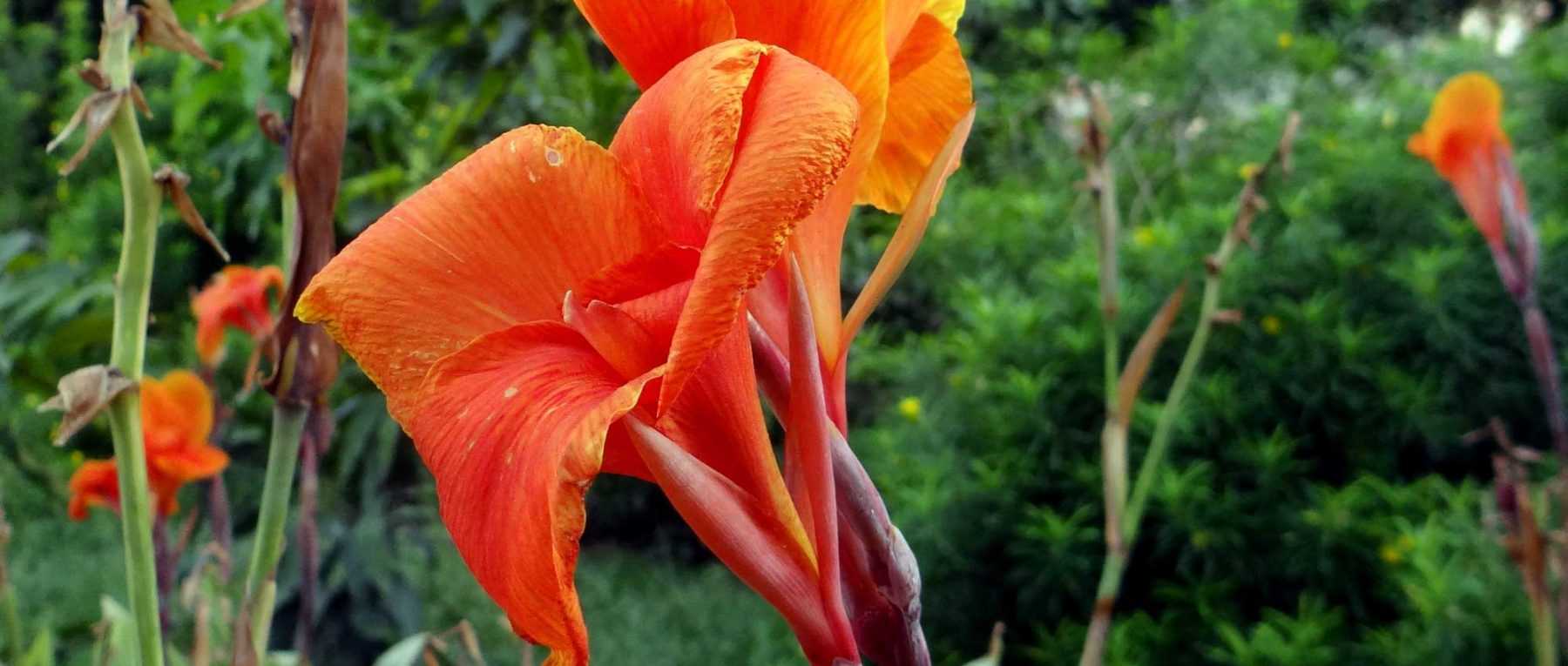
Canna: Planting, Growing and Caring
Contents
Cannas in a nutshell
- We appreciate cannas for the exotic touch they bring to the garden!
- They boast an impressive and majestic silhouette
- Their foliage is highly decorative, green or purple, sometimes striped
- In summer, they produce vibrant flowers in warm tones!
- Just like dahlias, their rhizomes can be stored frost-free throughout winter
Our Expert's Word
With their lush appearance and flamboyant blooms, cannas are the perfect plants to transport us to exotic climes, bringing a touch of the tropics to the garden! They are cherished as much for their summer flowers in warm hues of yellow, orange or red as for their highly decorative foliage, which may be green or purple, sometimes beautifully striped. Discover the stunning red blooms of the botanical species Canna indica… and those of numerous horticultural varieties, such as the orange-flowered Canna ‘Durban’, or the Canna ‘Cleopatra’, with its striking red and yellow variegated flowers…
Majestic and imposing plants, cannas instantly add substantial volume to flower beds! They certainly deserve a central position. They create an immediate dramatic effect, which is why they are often used in urban public spaces. However, their size can vary considerably: from giant cannas to dwarf varieties, perfect for container growing!
Resistant to most diseases and pests, these are robust, vigorous plants with rapid growth! Generally, they are not very hardy, though some varieties can tolerate temperatures as low as -10°C. To produce abundant, beautiful blooms, they require a warm position, plenty of moisture and rich soil! Planting takes place in spring, once the risk of frost has passed… or indoors in winter for later transplanting, to get a head start! While cannas can be grown from seed, they also propagate very well by rhizome division.
Botany
Botanical data
- Latin name Canna sp.
- Family Cannaceae
- Common name Canna, Indian Shot
- Flowering July to October-November
- Height between 60 cm and 2.50 m
- Exposure full sun
- Soil type rich, fertile, moist, well-drained
- Hardiness variable. Often 0°C, sometimes –8°C, but down to –15°C for Canna indica.
The canna, also known as Indian Shot, is a perennial rhizomatous plant native to tropical and subtropical regions of the Americas (Central America, South America, the Caribbean…)… which explains its frost-tender nature! It has naturalised in several regions of the world (Australia, New Zealand, Southeast Africa, Hawaii…). In the wild, it is found in wetlands, forest edges, and along riverbanks. Many hybrid varieties are cultivated in gardens. It is prized both for its lush foliage and its flamboyant flowers. There are about a dozen botanical species of Cannas. The most common in cultivation is Canna indica, also called Canna edulis.
The name canna comes from the Greek κάννα (kanna), meaning reed or rush. The species name indica means “from the Indies” (West Indies, as the species originates from the Americas). Its other species name, edulis (a synonym of C. indica), means edible. The canna is also known by the vernacular name Indian Shot. In South America, it is also called Achira.
Cannas are closely related to ginger, banana plants, heliconias, and strelitzias. Their foliage indeed resembles that of banana plants. The canna belongs to the Cannaceae family, of which it is the sole representative! This family includes no other plant genus. They are monocotyledons, like grasses, palms, or orchids.
Cannas form large clumps of upright, imposing leaves. They are vigorous, fast-growing plants. The stems are straight, sturdy, and unbranched. The smallest varieties reach no more than 60 cm in height, while the tallest can grow up to 2.50 m, or even more! This is particularly true of Canna musifolia. Wild species are often taller than horticultural varieties.
Cannas flower from July to October-November. They offer the advantage of a long flowering period. The flowers are terminal, clustered in spikes atop erect stems rising above the foliage.
Cannas are remarkable for their dazzling blooms! The flowers always display warm, vibrant colours. Depending on the variety, they can be golden yellow, orange, or red, sometimes pink… They may also be cream or salmon. There are even a few white-flowered varieties, though these are less common. The flowers are often bicoloured or spotted… Sometimes, a single plant bears flowers with different colours and patterns, as with Canna ‘Cleopatra’.
Hybrids offer truly impressive blooms, with large, broad-petalled flowers, often spotted, while the botanical species Canna indica has more delicate flowers.
The flowers are unique, irregular, and may resemble iris or orchid blooms. They typically measure 5 to 10 cm in diameter. Each flower consists of three petals and three sepals, though these are small and somewhat inconspicuous. The showy staminodes (modified stamens) mimic petals with their broad shape and vibrant colours! There are four sterile, petal-like staminodes and one fertile stamen bearing pollen.


Cannas often flower in vibrant, warm hues! Canna ‘Striata’, Canna ‘Red King Humbert’, and Canna ‘Yellow Humbert’ (photo Mauroguanandi)
Cannas are as prized for their flowers as for their foliage! The lush leaves alone make them highly decorative, even without blooms. They boast large, oblong, very broad leaves that give them a luxuriant appearance. The leaf tips are pointed and acuminate. The leaves are simple, entire, alternately arranged, and sheath the stem at the base.
Canna foliage is particularly elegant; its majestic, luxuriant appearance is much admired! The leaves often measure 40 to 60 cm long, sometimes up to 1 m. They reach 10 to 30 cm in width. Their leaves resemble those of banana plants, especially in Canna musifolia, which owes its name (literally, “banana-leaf canna”) to this resemblance.
The leaves are usually green, but purple foliage is also common. They can be very dark, almost black, as in Canna ‘Australia’. This creates a stunning contrast with the bright flowers, making them stand out even more. Sometimes, the foliage changes colour over time! This is the case with Canna ‘Durban’, whose leaves display remarkable warm-toned hues. The leaves may also be variegated with white-cream, as in ‘Stuttgart’. Many varieties feature striking striations, where the veins contrast with the leaf blade. These are golden-yellow in Canna striata.


Cannas offer superb foliage, varying greatly between varieties! From left: Canna ‘Durban’, Canna ‘Stuttgart’, and Canna ‘Striata’
Though sometimes mistaken for a bulbous plant, the canna actually grows from a thick rhizome (a swollen underground stem) that stores nutrients as starch. This allows easy propagation by division. The rhizome of Canna indica is edible.
After flowering, cannas produce surprising fruits: rounded capsules covered in small spines. These capsules are often reddish or purplish, somewhat resembling castor beans. They contain beautiful round, black, glossy seeds, sometimes used as beads in jewellery. You can harvest them for sowing. The seeds are very hard, so soaking them in warm water before sowing is recommended.
Although cannas are relatively tender and need lifting in autumn in cold regions, some species tolerate cold quite well. Canna indica and Canna musifolia can withstand temperatures down to –10°C. Nevertheless, we recommend applying a thick mulch to protect them from frost.
There are also aquatic cannas, which can be grown directly in water. These varieties are typically derived from Canna glauca.
The main varieties of Canna
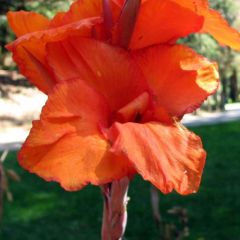
Canna Wyoming - Indian shot
- Flowering time August to November
- Height at maturity 1,50 m
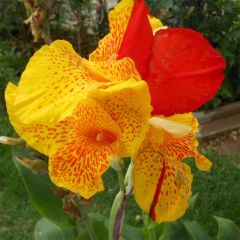
Canna Cleopatra - Indian shot
- Flowering time August to December
- Height at maturity 1,20 m
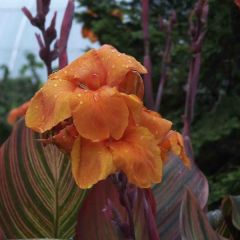
Canna Durban - Indian shot
- Flowering time August to December
- Height at maturity 1,50 m
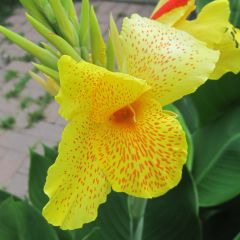
Canna En Avant - Indian shot
- Flowering time August to November
- Height at maturity 1,50 m

Canna Musifolia - Canna Lily
- Flowering time August, September
- Height at maturity 2,80 m
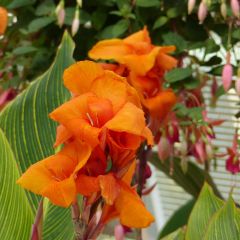
Canna Striata - Indian shot
- Flowering time August to October
- Height at maturity 1,50 m
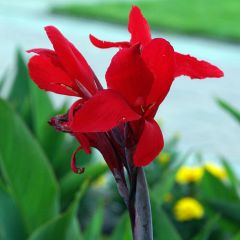
Canna Firebird - Indian shot
- Flowering time August to December
- Height at maturity 90 cm

Canna Stuttgart - Indian shot
- Flowering time August to December
- Height at maturity 1,20 m
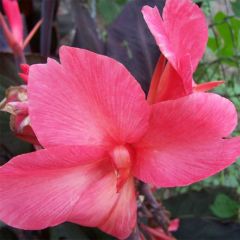
Canna Felix Roux - Indian shot
- Flowering time August to December
- Height at maturity 60 cm
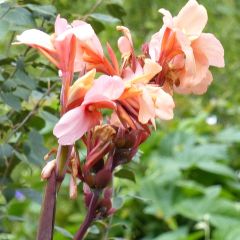
Canna Madame Angèle Martin - Indian shot
- Flowering time August to December
- Height at maturity 1,60 m
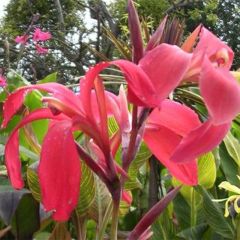
Canna Endeavour - Indian shot
- Flowering time September to December
- Height at maturity 2,50 m
Discover other Cannas
Planting canna
Where to plant canna?
Cannas need warmth… Place them in full sun! Their flowering may be much less impressive if planted in shade. Similarly, choose a spot sheltered from prevailing winds.
Cannas are relatively hungry plants; they thrive in humus-rich, fertile soil. It’s always beneficial to add compost or well-rotted manure to enrich the soil before planting. They prefer deep, loose soil. As they naturally grow in damp areas or along riverbanks, cannas appreciate soil that remains relatively moist, but it’s important to ensure good drainage.
You can plant cannas near a pond, for example alongside ferns, gunneras or Asian primroses… Especially if growing Canna glauca, which thrives with its roots submerged in water! Other aquatic canna varieties include ‘Erebus’ or ‘Endeavour’.
Cannas can adapt to container planting, ideal for decorating a balcony or terrace, but choose compact varieties like Canna ‘Felix Roux’.
Since cannas are tropical or subtropical plants and not always fully hardy, they can also be grown in a greenhouse or conservatory.
→ Read also: Growing canna in pots
When to plant?
Plant cannas outdoors in spring, in May or June, once the risk of frost has passed. In milder regions, planting can start as early as April.
To get a head start, plant rhizomes in pots (in February-March), keeping them indoors before moving them outside once temperatures rise.
How to plant cannas?
In pots:
To encourage faster growth and earlier flowering, plant rhizomes in pots indoors at the end of winter, keeping them in a heated space… Then transplant them into the garden after the last frost.
- Choose a pot at least 30 cm in diameter and fill it with compost.
- Plant the rhizome about 10 cm deep.
- Cover with soil and firm gently.
- Water well.
- Place the pot in a greenhouse, conservatory or indoors.
They can be moved outdoors from late May. We recommend acclimatising them gradually by placing them in a cooler sheltered spot before planting outside permanently.
Garden planting:
In the ground, space plants 50-60 cm apart… or up to 1 m for taller varieties.
- Prepare the soil. We suggest adding well-rotted manure or compost, as cannas thrive in rich soil.
- Plant the rhizome about 10 cm deep. If pre-grown in a pot, transplant the leafy plant directly.
- Backfill and firm lightly.
- Water thoroughly.
Aquatic cannas, like Canna glauca, can be planted in ponds, submerged under about 10 cm of water.
Maintenance
Cannas require some maintenance. It’s best to remove faded flowers, as this encourages longer flowering. Once a flower stem has completely finished blooming and no longer carries buds, you can cut it back.
Water regularly in summer, as cannas appreciate relatively cool soil (but avoid excessive moisture). We also recommend mulching the soil to prevent it from drying out too quickly. Watering will need to be slightly more frequent if grown in pots!
We suggest applying fertiliser or organic matter in spring, when the plant is in full growth. Cannas love rich soil! You can spread a layer of compost or well-rotted manure around their base… For potted plants, use a nitrogen-rich fertiliser.
Overwintering:
Lift cannas in autumn (October-November), before the first frosts, to protect them from the cold:
- Dig up the clumps with a garden fork, taking care not to damage the rhizomes.
- Select the healthiest rhizomes.
- Cut back faded stems and leaves to about 10 cm from the base, then let the rhizomes dry.
- Place them in a crate filled with sand or compost, stored in a dry, airy, frost-free spot.
- You can replant them in spring.
If you live in a warm climate, you can leave the rhizomes in the ground, but protect them with a thick mulch! Also cut back the foliage to about 10 cm above the ground once it has faded. Finally, if growing cannas in pots, simply move them into a greenhouse or conservatory. If temperatures stay above 10°C, they can remain in growth and continue flowering in winter.
→ Read also: Overwintering summer bulbs with Virginie’s advice!
Cannas rarely suffer from diseases or pests—though slugs and snails may sometimes nibble young shoots in spring. They can also occasionally be attacked by spider mites, which cause foliage discolouration.
Propagation
Cannas are mainly propagated by division – a fairly simple technique that ensures you get exactly the same variety. It is also possible to sow canna seeds.
Sowing
You can either collect seeds from your cannas (if you’ve left some faded flowers on your plants) or buy them directly. Sowing takes place in early spring.
- Fill a thermos with hot water, then place the seeds in it for 24 hours. The outer seed coat is very hard, and soaking the seeds helps soften it. Sometimes it’s recommended to scarify the seeds by rubbing them with sandpaper just before placing them in water, but this step is optional.
- Remove the seeds from the water.
- Fill a pot or tray with special seed compost.
- Sow the seeds.
- Cover them with substrate.
- Water.
- Place the pot in a bright spot at a temperature between 20 and 25°C.
Once the seeds have germinated, the young seedlings grow quite quickly, but it’s unlikely the plant will flower in the same year as sowing… you’ll often have to wait at least until the second year to enjoy the flowers!
Rhizome Division
Divide your cannas in late winter, around March.
- Dig up the rhizomes if they’re in the ground, or choose rhizomes from those you’ve stored frost-free over winter. You can remove excess soil to make the rhizome more visible.
- Cut them into several pieces using a knife or by hand. Each piece should have roots and at least one bud.
- Fill a few pots with compost, optionally mixed with a little sand.
- Plant the rhizome pieces.
- Place the pots under cover in a relatively warm spot. This allows them to start growing under optimal conditions.
- You can then move them outside once temperatures have warmed up and there’s no more risk of frost.
Also check out our tutorial How to Propagate Cannas, and our video advice:
Association
Cannas are obviously perfect for creating an exotic border! Pair the vibrant colours of cannas with other flamboyant blooms, such as crocosmias, kniphofias or hedychiums… Add plants with broad, lush foliage: banana plants, colocasias, castor oil plants, and possibly palms and tree ferns. The idea is to gather luxuriant vegetation, punctuated by some impressive blooms.
Since they love moisture and cool soils, you can plant cannas at the edge of a pond… Or even in water, for Canna glauca! Create lush vegetation on the banks with ferns, gunneras or colocasias… Enjoy the delicate flowering of Schizostylis coccinea, and the stunning red flowers of Lobelia cardinalis. You can add some graphic and airy plants, such as ornamental grasses, horsetails, or rushes…
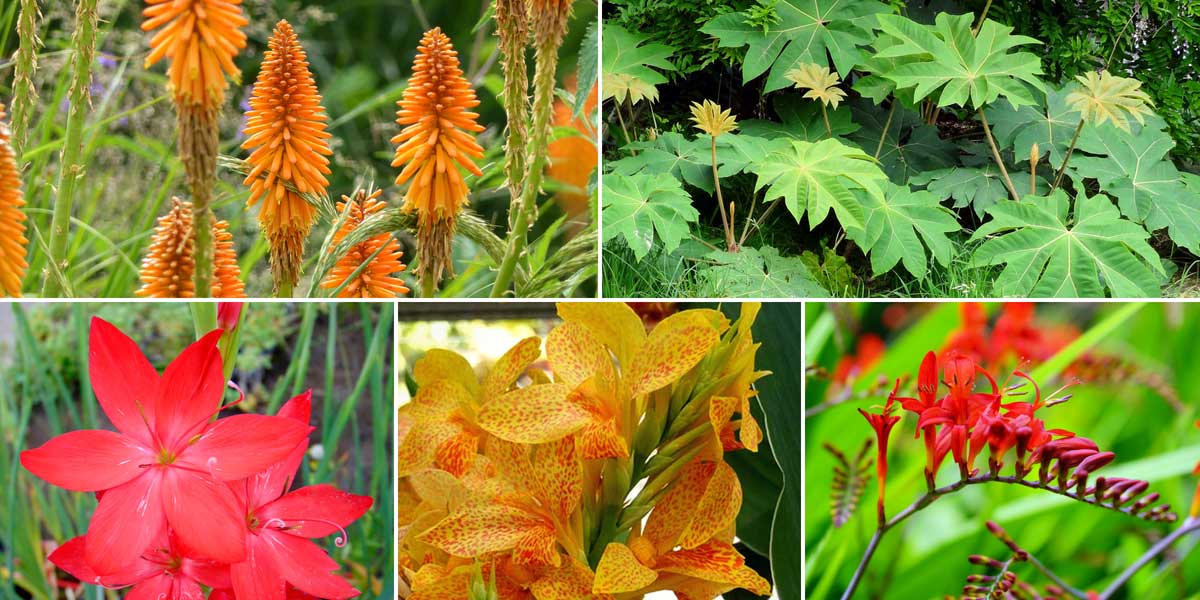

An association idea for an exotic garden: Kniphofia ‘Fiery Fred’, Tetrapanax papyrifera ‘Rex’, Schizostylis coccinea ‘Major’, Canna ‘Picasso’ and Crocosmia
Incorporate cannas into a colourful summer border, among rudbeckias, cosmos, coreopsis, dahlias, gladioli, crocosmias, shrubby salvias… You’ll create an eye-catching and impressive border, like a focal point in your garden! Compose a stunning summer scene by planting cannas with purple foliage alongside bright red dahlias and orange-flowered crocosmias. You could also add some colourful gladioli and daylilies! You might also include some pennisetums, whose plumes will add movement and lightness!
Use cannas to add volume and height to a border, placing a few clumps among slightly shorter perennials. Similarly, cannas can also be used to add small splashes of colour to a more subdued, less colourful border. They’ll bring dynamism and vitality!
Don’t hesitate to plant cannas as standalone specimens, for example in the middle of a lawn, to showcase them even more.
→ Discover more ideas for pairing with Cannas in our advice sheet.
Did you know?
- An edible and useful plant
The rhizomes of Canna edulis are edible and were traditionally consumed by Native Americans. They are still used in some regions (Caribbean, South America, Southeast Asia…). Rich in starch, they can be eaten as flour or cooked like potatoes. Cannas are also sometimes used as animal feed for livestock.
The black, very hard seeds can be used as beads for making jewellery. They are also used to make the kayamb, a traditional musical instrument from Réunion.
The canna rhizome has medicinal properties.
Useful resources
- Discover our range of cannas!
- Our video advice – Dividing a canna
- An association idea for integrating cannas into your garden: Exotic Ambience
- Our advice sheet: 8 orange-flowering summer bulbs
- Our advice sheets: How to choose a canna?, growing a canna in a pot, where and how to plant cannas?; propagating your cannas and Our secrets for keeping cannas in flower all summer.
Frequently asked questions
-
My cannas aren't flowering!
If you've grown them from seed, you may sometimes have to wait until the second year to see them flower... Otherwise, perhaps you started them too late. Cannas take a long time to bloom, which is why it's best to plant them in pots indoors during winter, then move them outdoors once the risk of frost has passed.
Above all, ensure their growing conditions are suitable: cannas need warmth and moisture to flower well! Plant them in full sun and water them regularly in summer. They will also appreciate a feed of fertiliser or compost. If you're growing them in a region that's too cold, some varieties may also struggle to flower.
- Subscribe!
- Contents
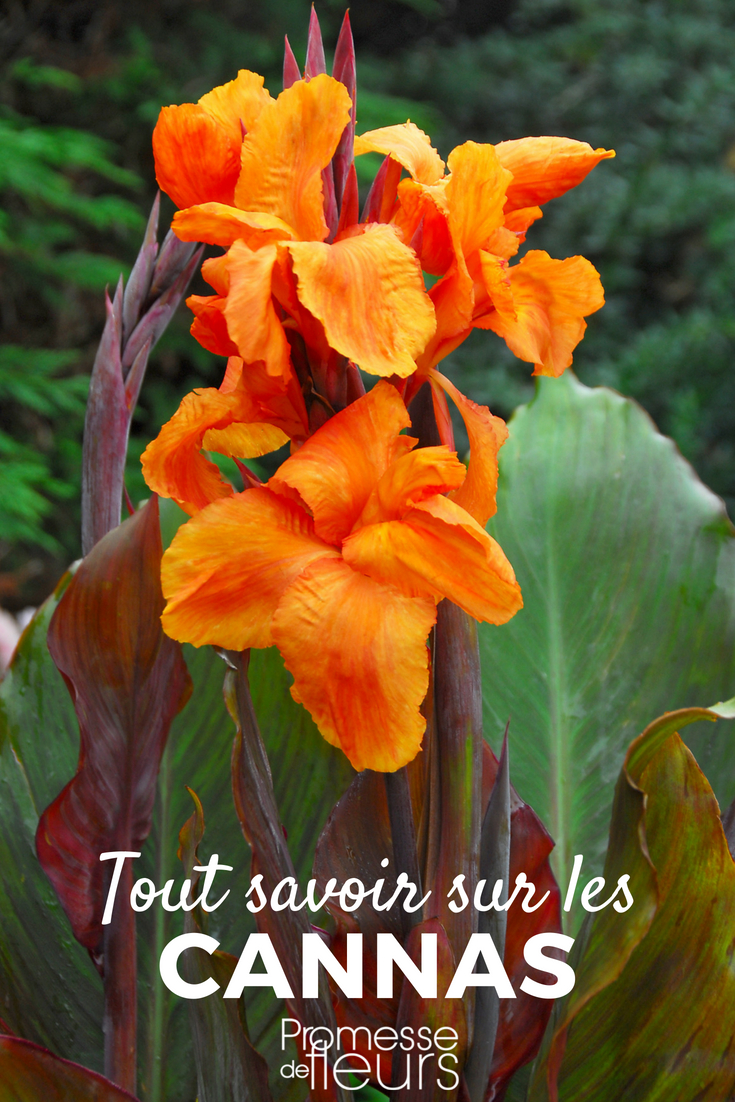


































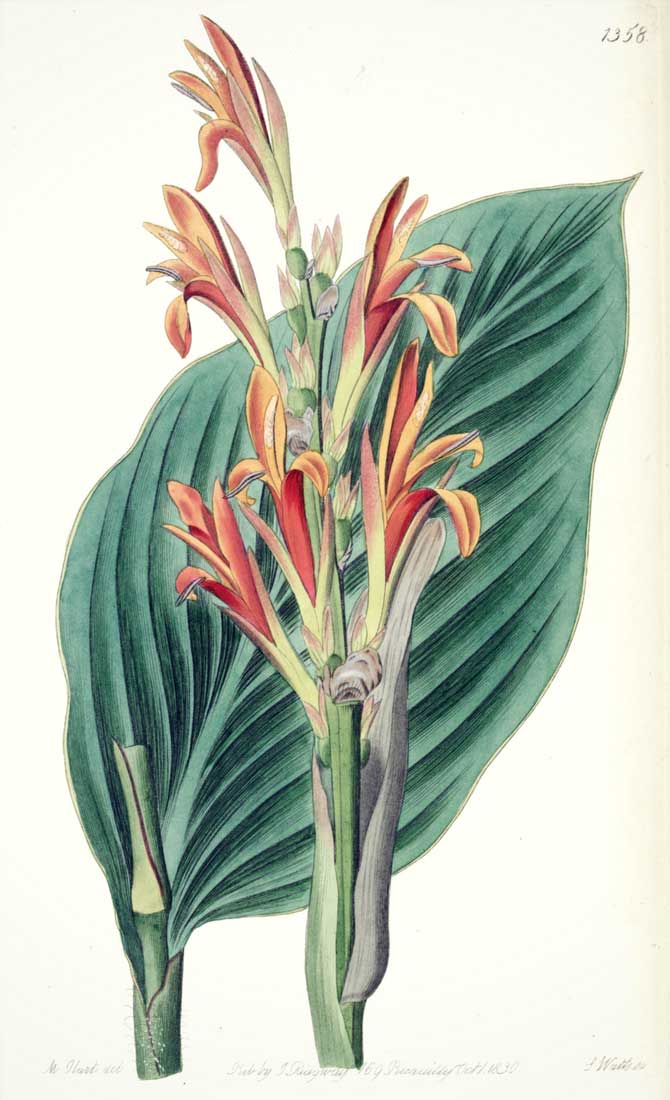


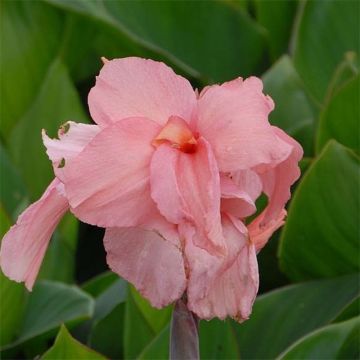
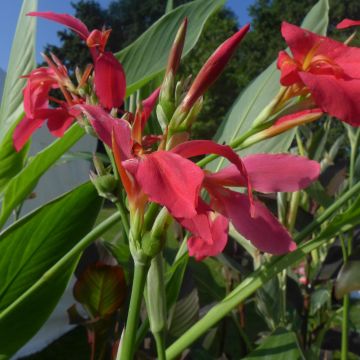
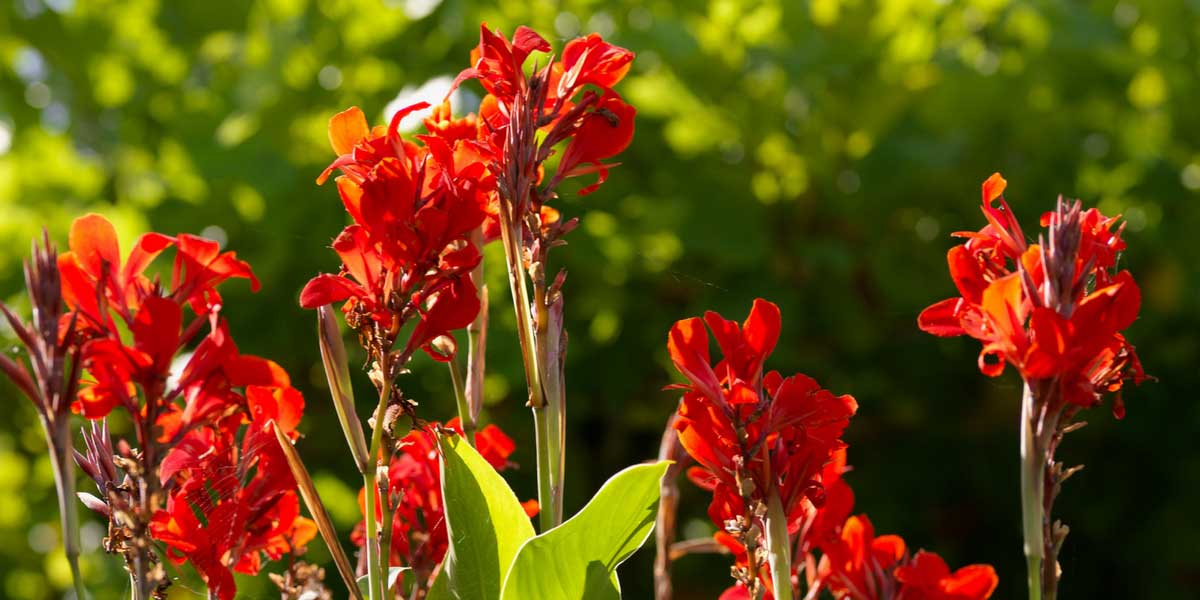
Comments